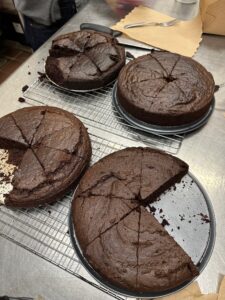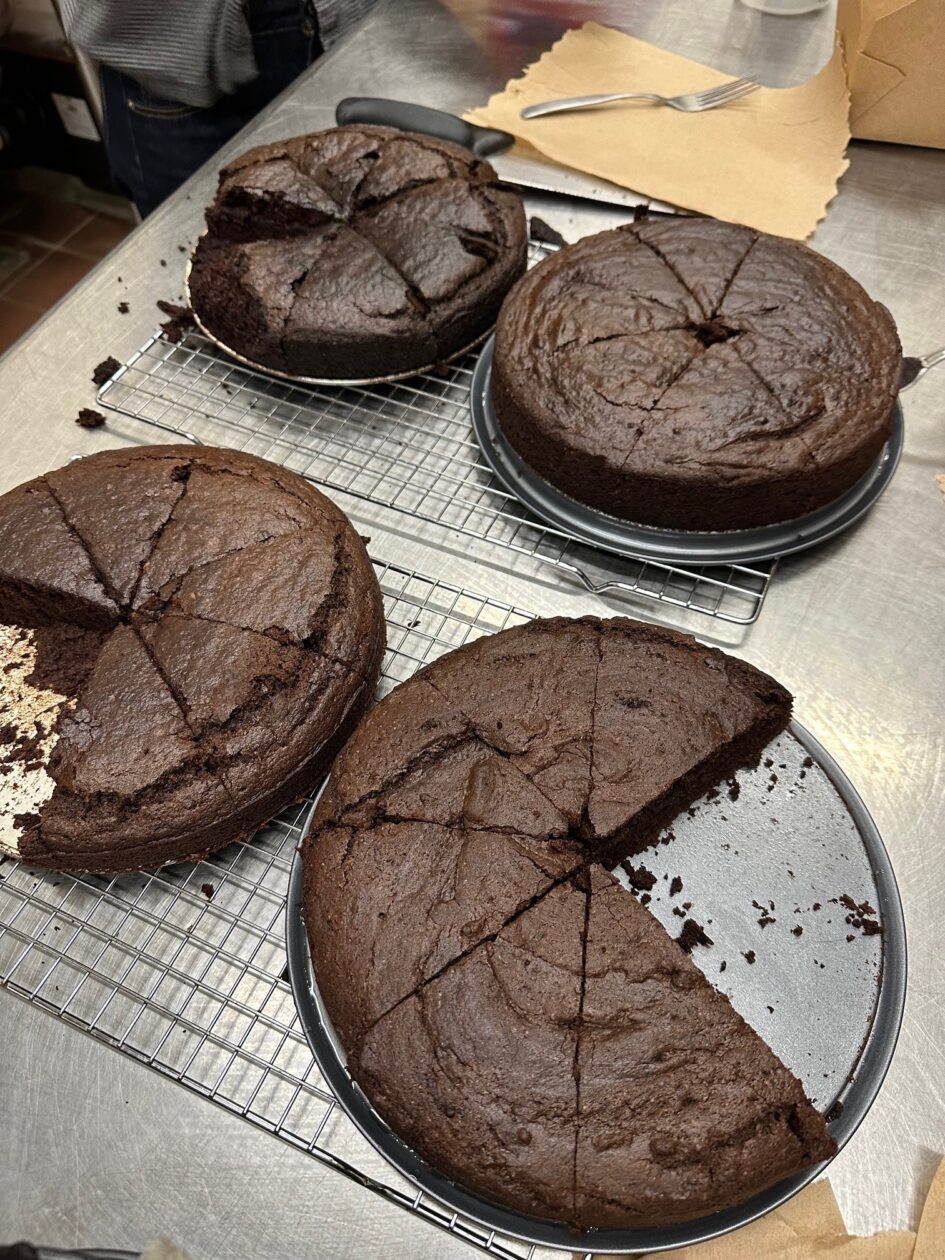We’re back with another recipe from the College Farm’s cooking classes on campus – this time a baking class! Professor Siobhan Phillips walked our students through four different chocolate cake recipes, each with a different substitute for eggs, to compare and taste test the final product. Needless to say, all four cakes turned out amazing – and our students learned so much about sustainable choices and easy swaps in baking! Learn these recipes from Professor Phillips below and check out the wonderful resources provided at the end.
Vegan Chocolate Cake Template Recipe
Vegan cake baking is easier than it might sound! At its simplest, it’s about replacing animal fat, animal milk, and eggs. Replacements of fat and milk are fairly straightforward. Replacement of eggs requires some creativity. Below, I offer a very basic template for vegan chocolate cake. It’s light, flavorful, and not too sweet, the kind of thing you can eat with a cup of coffee for a mid-morning snack, or frost and serve as a more elaborate dessert. I’ve offered four versions—with four different alternatives to eggs. During the class we’ll bake all four to see differences, side by side (something we can’t easily do otherwise, maybe). You can get a sense of which alternatives are most appealing to you.
I hope the alternatives here are just the start, though, of your cake ideas. A truism of food prep is that cooking can be very improvisational, but baking must be very precise. Yes—but. Baking can be improvisational, too! To think about sustainability in baking—even beyond vegan ingredients—can be a great spur to try different variations and see what they add. After these templates, I’ve provided some notes on modifications and resources to look at.
1.) Basic, no egg replacement
|
a) 225 grams soy milk 15 grams apple-cider vinegar 225 grams sugar 125 grams canola oil 15 grams vanilla or strong coffee |
b) 225 grams flour 50 grams cocoa 4 grams baking powder 5 grams baking soda 4 grams salt |
2.) With aquafaba
|
a) 200 grams soy milk 15 grams apple-cider vinegar 225 grams sugar 125 grams canola oil 15 grams vanilla or strong coffee |
b) 225 grams flour 50 grams cocoa 4 grams baking powder 5 grams baking soda 4 grams salt |
|
c) 90 grams whipped aquafaba |
3.) With flax
|
a) 200 grams soy milk 15 grams apple-cider vinegar 225 grams sugar 125 grams canola oil 15 grams vanilla or strong coffee 20 grams flax whisked into 50 grams water |
b) 225 grams flour 50 grams cocoa 4 grams baking powder 5 grams baking soda 4 grams salt |
4.) With silken tofu
|
a) 20 grams soy milk 15 grams apple-cider vinegar 225 grams sugar 125 grams canola oil 15 grams vanilla or strong coffee 200 grams silken tofu |
b) 225 grams flour 50 grams cocoa 4 grams baking powder 5 grams baking soda 4 grams salt |
Directions for all four versions
- Preheat the oven to 350 degrees Fahrenheit.
- Grease an 8-inch round or 8-inch square pan: add approximately 5 grams oil to the empty pan, use a pastry brush to spread the oil into a film across the entire inside. Or: line the pan with parchment paper.
- In a medium bowl, combine the a) ingredients. Whisk until well combined.
- In a large bowl, combine the b) ingredients. Stir until well combined.
- Add the a) ingredients to the large bowl of b) ingredients. Stir until just combined.
For #2 (aquafaba) only: fold the c) aquafaba gently into the batter at this point.
- Smooth the batter into the prepared pan.
- Bake for about 32 minutes. Start checking at 27. Stick in a toothpick—it should come out clean.
- Let the cake cool for approximately 1 hour before turning it out of the pan. Then frost (if desired), slice, and eat (or freeze for later). The cake keeps well at room temperature for about four days.

Substitutions, Experiments, and Creativity:
Try different flours, sweeteners, oils, flavorings, and additions.
In general, substituting different oil may change the flavor but should not cause baking problems.
Substituting different sweeteners will affect flavor—but also moisture and density. In general, though, you can be bold with substituting other solid sugars and even syrups. Record results!
Substituting another flour—spelt, whole wheat, oat, almond, etc.—is trickiest (but also super rewarding in terms of flavor). Different flours will change the moisture level and texture of the cake. Try adding some smaller proportion first, then up the percentage, adjusting levels of oil and milk.
Think about mix-ins (fruit, nuts, etc.).
You can also, of course, get rid of the cocoa—if you do, cut down a little on sugar, milk, and oil.
For all experiments: jot down what you did so you know what to try next time!
Resources and Considerations
Thinking about sustainable baking can be a complex but fascinating process. Here are some useful books/sites:
- The organization Our World in Data, and its website, offers facts about how different foods impact climate change.
- Eating to Extinction, by Dan Saladino, is a wonderfully enlivening book about rare and genetically diverse ingredients—why should know them, protect them, and potentially use them.
- Harold McGee’s On Food and Cooking: The Science and Lore of the Kitchen is a great place to learn about the science of different ingredients—so you know how to substitute for them well!
- Mother Grains, by Roxana Jullapat, is a terrific resource full of recipes with sustainable, lesser-known grains.
- The newsletter “Pale Blue Tart,” created by Caroline Saunders, explores sustainable baking.
- The website “Rainbow Plant Life,” created by Nisha Vora, has expert instruction on vegan baking (and cooking) of all kinds.
- The eponymous newsletter “From the Desk of Alicia Kennedy” explores sustainable eating from many angles. (The author once ran a vegan bakery.) My own template draws from Alicia’s.
Don’t forget local growers of grain and other ingredients, at Farmers on the Square or local farms!
And don’t forget local bakers—at Farm Works as well as Farmers on the Square.
Take inspiration from ingredients, and from what you taste and like! Enjoy!

Leave a Reply